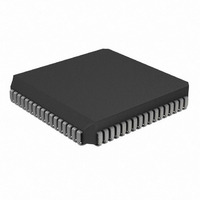PIC17LC756A-08/L Microchip Technology, PIC17LC756A-08/L Datasheet - Page 95

PIC17LC756A-08/L
Manufacturer Part Number
PIC17LC756A-08/L
Description
IC MCU OTP 16KX16 A/D 68PLCC
Manufacturer
Microchip Technology
Series
PIC® 17Cr
Specifications of PIC17LC756A-08/L
Core Processor
PIC
Core Size
8-Bit
Speed
8MHz
Connectivity
I²C, SPI, UART/USART
Peripherals
Brown-out Detect/Reset, POR, PWM, WDT
Number Of I /o
50
Program Memory Size
32KB (16K x 16)
Program Memory Type
OTP
Ram Size
902 x 8
Voltage - Supply (vcc/vdd)
3 V ~ 5.5 V
Data Converters
A/D 12x10b
Oscillator Type
External
Operating Temperature
0°C ~ 70°C
Package / Case
68-PLCC
Processor Series
PIC17LC
Core
PIC
Data Bus Width
8 bit
Data Ram Size
902 B
Interface Type
I2C, MSSP, RS- 232, SCI, SPI, USART
Maximum Clock Frequency
8 MHz
Number Of Programmable I/os
50
Number Of Timers
8
Operating Supply Voltage
3 V to 5.5 V
Maximum Operating Temperature
+ 70 C
Mounting Style
SMD/SMT
Minimum Operating Temperature
0 C
On-chip Adc
12 bit
Lead Free Status / RoHS Status
Lead free / RoHS Compliant
Eeprom Size
-
Lead Free Status / Rohs Status
Details
Available stocks
Company
Part Number
Manufacturer
Quantity
Price
Company:
Part Number:
PIC17LC756A-08/L
Manufacturer:
MICROCHIP
Quantity:
12 000
Company:
Part Number:
PIC17LC756A-08/L
Manufacturer:
Microchip Technology
Quantity:
10 000
- Current page: 95 of 304
- Download datasheet (6Mb)
11.0
The PIC17C7XX has four timer modules. Each module
can generate an interrupt to indicate that an event has
occurred. These timers are called:
• Timer0 - 16-bit timer with programmable 8-bit
• Timer1 - 8-bit timer
• Timer2 - 8-bit timer
• Timer3 - 16-bit timer
For enhanced time base functionality, four input Cap-
tures and three Pulse Width Modulation (PWM) outputs
are possible. The PWMs use the Timer1 and Timer2
resources and the input Captures use the Timer3
resource.
11.1
The Timer0 module is a simple 16-bit overflow counter.
The clock source can be either the internal system
clock (Fosc/4) or an external clock.
When Timer0 uses an external clock source, it has the
flexibility to allow user selection of the incrementing
edge, rising or falling.
The Timer0 module also has a programmable pres-
caler. The T0PS3:T0PS0 bits (T0STA<4:1>) determine
the prescale value. TMR0 can increment at the follow-
ing rates: 1:1, 1:2, 1:4, 1:8, 1:16, 1:32, 1:64, 1:128,
1:256.
Synchronization of the external clock occurs after the
prescaler. When the prescaler is used, the external
clock frequency may be higher than the device’s fre-
quency. The maximum external frequency on the
T0CKI pin is 50 MHz, given the high and low time
requirements of the clock.
11.2
The Timer1 module is an 8-bit timer/counter with an 8-
bit period register (PR1). When the TMR1 value rolls
over from the period match value to 0h, the TMR1IF
flag is set and an interrupt will be generated if enabled.
In Counter mode, the clock comes from the RB4/
TCLK12 pin, which can also be selected to be the clock
for the Timer2 module.
TMR1 can be concatenated with TMR2 to form a 16-bit
timer. The TMR1 register is the LSB and TMR2 is the
MSB. When in the 16-bit timer mode, there is a corre-
sponding 16-bit period register (PR2:PR1). When the
TMR2:TMR1 value rolls over from the period match
value to 0h, the TMR1IF flag is set and an interrupt will
be generated, if enabled.
prescaler
2000 Microchip Technology Inc.
OVERVIEW OF TIMER
RESOURCES
Timer0 Overview
Timer1 Overview
11.3
The Timer2 module is an 8-bit timer/counter with an 8-
bit period register (PR2). When the TMR2 value rolls
over from the period match value to 0h, the TMR2IF
flag is set and an interrupt will be generated, if enabled.
In Counter mode, the clock comes from the RB4/
TCLK12 pin, which can also provide the clock for the
Timer1 module.
TMR2 can be concatenated with TMR1 to form a 16-bit
timer. The TMR2 register is the MSB and TMR1 is the
LSB. When in the 16-bit timer mode, there is a corre-
sponding 16-bit period register (PR2:PR1). When the
TMR2:TMR1 value rolls over from the period match
value to 0h, the TMR1IF flag is set and an interrupt will
be generated, if enabled.
11.4
The Timer3 module is a 16-bit timer/counter with a 16-
bit period register. When the TMR3H:TMR3L value
rolls over to 0h, the TMR3IF bit is set and an interrupt
will be generated, if enabled. In Counter mode, the
clock comes from the RB5/TCLK3 pin.
When operating in the four Capture modes, the period
registers become the second (of four) 16-bit capture
registers.
11.5
The timer modules are general purpose, but have ded-
icated resources associated with them. TImer1 and
Timer2 are the time bases for the three Pulse Width
Modulation (PWM) outputs, while Timer3 is the time
base for the four input captures.
Timer2 Overview
Timer3 Overview
Role of the Timer/Counters
PIC17C7XX
DS30289B-page 95
Related parts for PIC17LC756A-08/L
Image
Part Number
Description
Manufacturer
Datasheet
Request
R

Part Number:
Description:
MICRO CTRL 16K LOW PWR 68PLCC
Manufacturer:
Microchip Technology
Datasheet:

Part Number:
Description:
MICRO CTRL 16K LOW PWR 64SDIP
Manufacturer:
Microchip Technology
Datasheet:

Part Number:
Description:
MICRO CTRL 16K LOW PWR 64SDIP
Manufacturer:
Microchip Technology
Datasheet:

Part Number:
Description:
MICRO CTRL 16K LOW PWR 68PLCC
Manufacturer:
Microchip Technology
Datasheet:

Part Number:
Description:
Manufacturer:
Microchip Technology Inc.
Datasheet:

Part Number:
Description:
Manufacturer:
Microchip Technology Inc.
Datasheet:

Part Number:
Description:
Manufacturer:
Microchip Technology Inc.
Datasheet:

Part Number:
Description:
Manufacturer:
Microchip Technology Inc.
Datasheet:

Part Number:
Description:
Manufacturer:
Microchip Technology Inc.
Datasheet:

Part Number:
Description:
Manufacturer:
Microchip Technology Inc.
Datasheet:

Part Number:
Description:
Manufacturer:
Microchip Technology Inc.
Datasheet:











